2007 ISUZU KB P190 low oil pressure
[x] Cancel search: low oil pressurePage 4245 of 6020
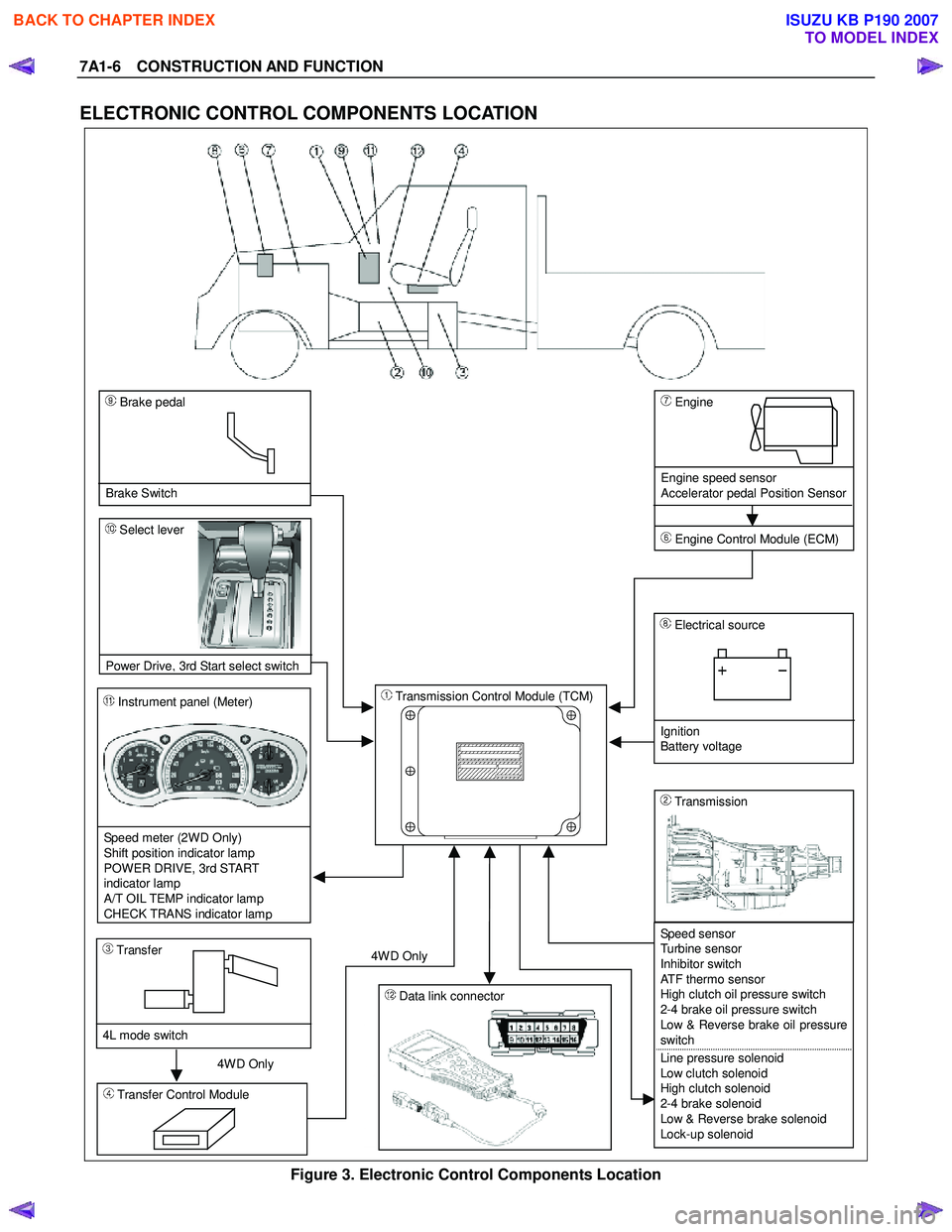
7A1-6 CONSTRUCTION AND FUNCTION
ELECTRONIC CONTROL COMPONENTS LOCATION
4WD Only 4W D Only
Instrument panel (Meter)
Speed meter (2WD Only)
Shift position indicator lamp
POWER DRIVE, 3rd START
indicator lamp
A/T OIL TEMP indicator lamp
CHECK TRANS indicator lam
p
Brake pedal
Brake Switch
Transmission Control Module (TCM)
Electrical source
Ignition
Battery voltage
Speed sensor
Turbine sensor
Inhibitor switch
ATF thermo sensor
High clutch oil pressure switch
2-4 brake oil pressure switch
Low & Reverse brake oil pressure
switch
Line pressure solenoid
Low clutch solenoid
High clutch solenoid
2-4 brake solenoid
Low & Reverse brake solenoid
Lock-up solenoid
Transmission
Transfer Control Module
Transfer
4L mode switch
Engine
Engine speed sensor
Accelerator pedal Position Sensor
Engine Control Module (ECM)
Data link connector
Select lever
Power Drive
, 3rd Start select switch
Figure 3. Electronic Control Components Location
BACK TO CHAPTER INDEX
TO MODEL INDEX
ISUZU KB P190 2007
Page 4247 of 6020
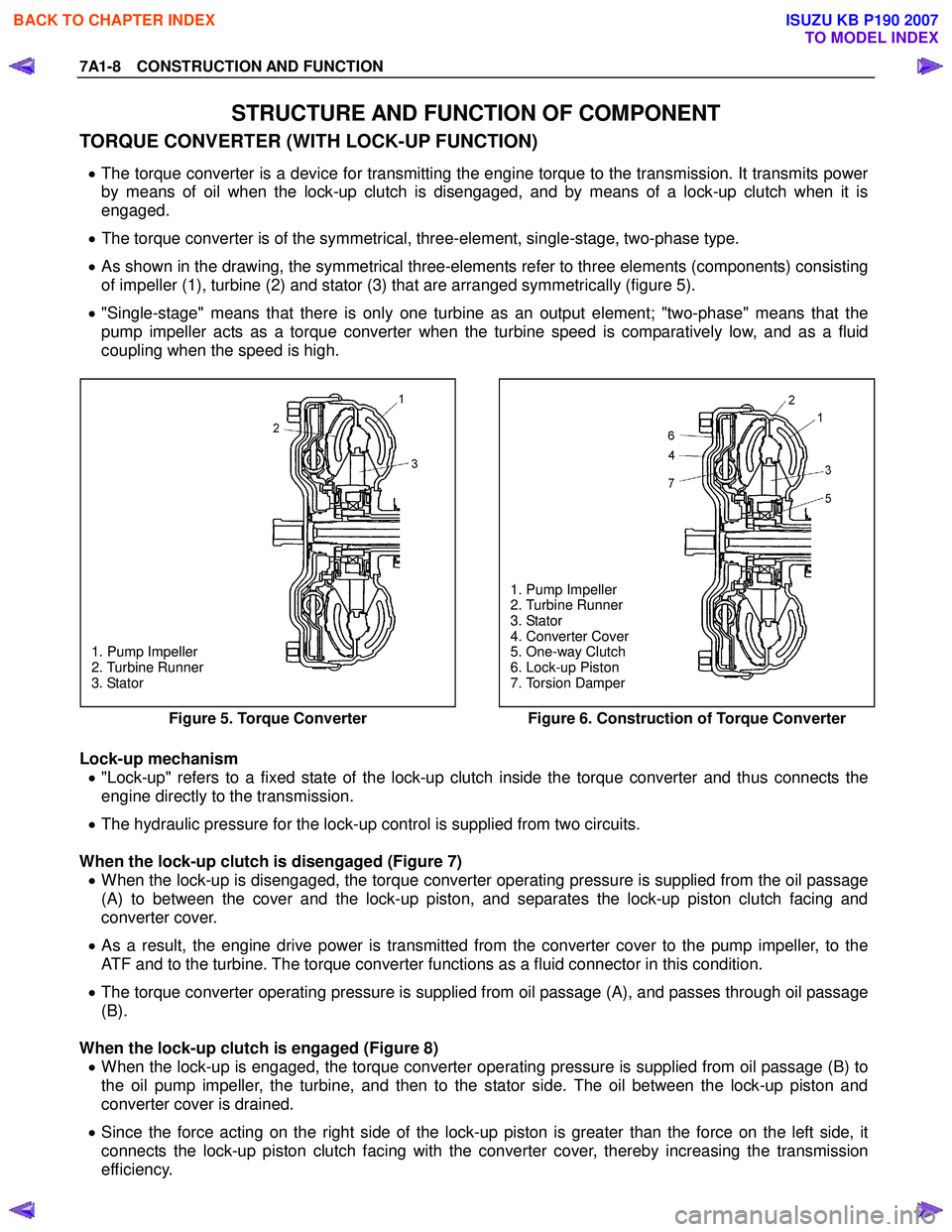
7A1-8 CONSTRUCTION AND FUNCTION
STRUCTURE AND FUNCTION OF COMPONENT
TORQUE CONVERTER (WITH LOCK-UP FUNCTION)
• The torque converter is a device for transmitting the engine torque to the transmission. It transmits power
by means of oil when the lock-up clutch is disengaged, and by means of a lock-up clutch when it is
engaged.
• The torque converter is of the symmetrical, three-element, single-stage, two-phase type.
• As shown in the drawing, the symmetrical three-elements refer to three elements (components) consisting
of impeller (1), turbine (2) and stator (3) that are arranged symmetrically (figure 5).
• "Single-stage" means that there is only one turbine as an output element; "two-phase" means that the
pump impeller acts as a torque converter when the turbine speed is comparatively low, and as a fluid
coupling when the speed is high.
1. Pump Impeller
2. Turbine Runner
3. Stator
1. Pump Impeller
2. Turbine Runner
3. Stator
4. Converter Cover
5. One-way Clutch
6. Lock-up Piston
7. Torsion Damper
Figure 5. Torque Converter
Figure 6. Construction of Torque Converter
Lock-up mechanism
• "Lock-up" refers to a fixed state of the lock-up clutch inside the torque converter and thus connects the
engine directly to the transmission.
• The hydraulic pressure for the lock-up control is supplied from two circuits.
When the lock-up clutch is disengaged (Figure 7) • When the lock-up is disengaged, the torque converter operating pressure is supplied from the oil pass age
(A) to between the cover and the lock-up piston, and separates the lock-up piston clutch facing and
converter cover.
• As a result, the engine drive power is transmitted from the converter cover to the pump impeller, to the
ATF and to the turbine. The torque converter functions as a fluid connector in this condition.
• The torque converter operating pressure is supplied from oil passage (A), and passes through oil passage
(B).
When the lock-up clutch is engaged (Figure 8) • When the lock-up is engaged, the torque converter operating pressure is supplied from oil passage (B) to
the oil pump impeller, the turbine, and then to the stator side. The oil between the lock-up piston and
converter cover is drained.
• Since the force acting on the right side of the lock-up piston is greater than the force on the left side, it
connects the lock-up piston clutch facing with the converter cover, thereby increasing the transmission
efficiency.
BACK TO CHAPTER INDEX
TO MODEL INDEX
ISUZU KB P190 2007
Page 4248 of 6020
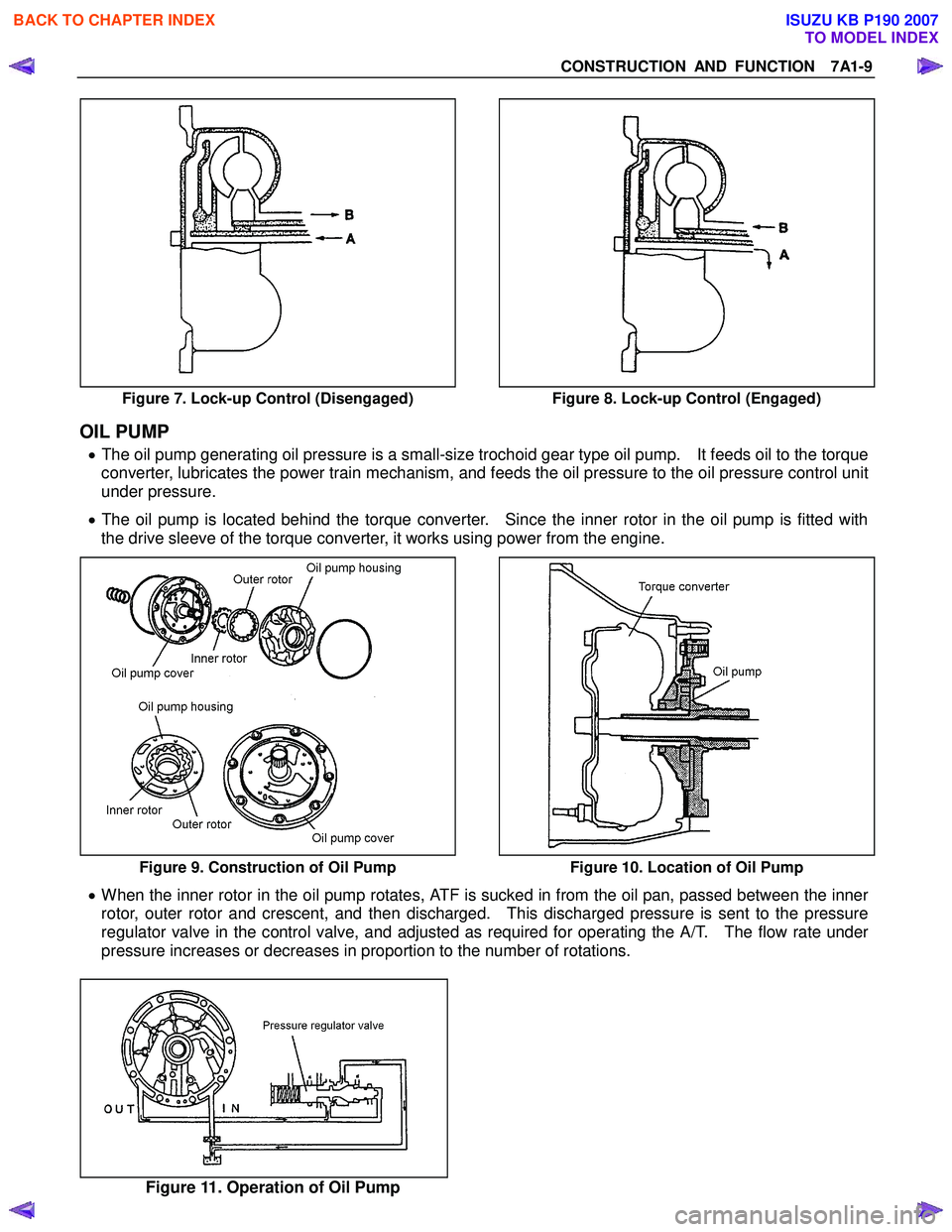
CONSTRUCTION AND FUNCTION 7A1-9
Figure 7. Lock-up Control (Disengaged) Figure 8. Lock-up Control (Engaged)
OIL PUMP
• The oil pump generating oil pressure is a small-size trochoid gear type oil pump. It feeds oil to the torque
converter, lubricates the power train mechanism, and feeds the oil pressure to the oil pressure control unit
under pressure.
• The oil pump is located behind the torque converter. Since the inner rotor in the oil pump is fitted with
the drive sleeve of the torque converter, it works using power from the engine.
Figure 9. Construction of Oil Pump Figure 10. Location of Oil Pump
• When the inner rotor in the oil pump rotates, ATF is sucked in from the oil pan, passed between the inner
rotor, outer rotor and crescent, and then discharged. This discharged pressure is sent to the pressure
regulator valve in the control valve, and adjusted as required for operating the A/T. The flow rate under
pressure increases or decreases in proportion to the number of rotations.
Figure 11. Operation of Oil Pump
BACK TO CHAPTER INDEX
TO MODEL INDEX
ISUZU KB P190 2007
Page 4250 of 6020

CONSTRUCTION AND FUNCTION 7A1-11
• The JR405E consists of two sets of planetary gears, which are called front planetary gear and rear
planetary gear.
• The sun gear of the front planetary gear is fixed to the drive plates of 2-4 brake and reverse clutch.
• The planetary carrier of the front planetary gear is fixed to the drum of the low clutch, the drive plates of
the low & reverse brake, and the hub of the high clutch.
• The internal gear of the front planetary gear, and the planetary carrier of the rear planetary gear, are
connected as one and fixed to the output shaft.
• The sun gear of the rear planetary gear is fixed to the input shaft.
• The internal gear of the rear planetary gear is fixed to the hub of the low clutch.
Clutch and Brake • Basic structure of the clutch and brake is shown in the figures below.
• In the figure A, the clutch plates (drive plate and driven plate) are released so that they slip against each
other, transmitting no power.
• Figure B shows the condition where the oil pressure is acting on the piston. The clutch plates are fitted
to each other under pressure, transmitting the rotations of the clutch drum to the clutch hub.
• When the oil pressure is removed from the piston, the clutch returns to the condition in figure A via the
return spring.
Figure 13. Basic Construction of Clutch and Brake
Low Clutch, High Clutch and Reverse Clutch (Multi-Plate Clutch) • The multi-plate clutch is composed of drive plates and driven plates. By applying the oil pressure onto
the end surface of the plates, the clutch is engaged. The oil pressure is adjusted with the control valve
according to the signal from the TCM.
• All clutches use dish plates to prevent uncontrolled operation of the clutches when engaged, causing a
shock.
• For the reverse clutch, a piston check ball is used to release the oil pressure. This prevents clutch drag
caused by oil pressure generated by residual ATF due to the centrifugal force while the clutch is racing
(under no oil pressure).
• For the low clutch and high clutch, a centrifugal balance chamber full of ATF is provided to offset the
excessive oil pressure. This prevents clutch drag caused by oil pressure generated by residual ATF due
to the centrifugal force while the clutch is racing (under no oil pressure).
• The solenoid in the control valve is driven based on the shift signal from TCM, it moves the shift valve,
thereby engaging the drive plate and driven plate through the piston of each clutch.
• As a result, elements of the planetary gear unit are combined.
• When the oil pressure is removed, the piston returns to the original position via the force of the return
spring.
BACK TO CHAPTER INDEX
TO MODEL INDEX
ISUZU KB P190 2007
Page 4252 of 6020
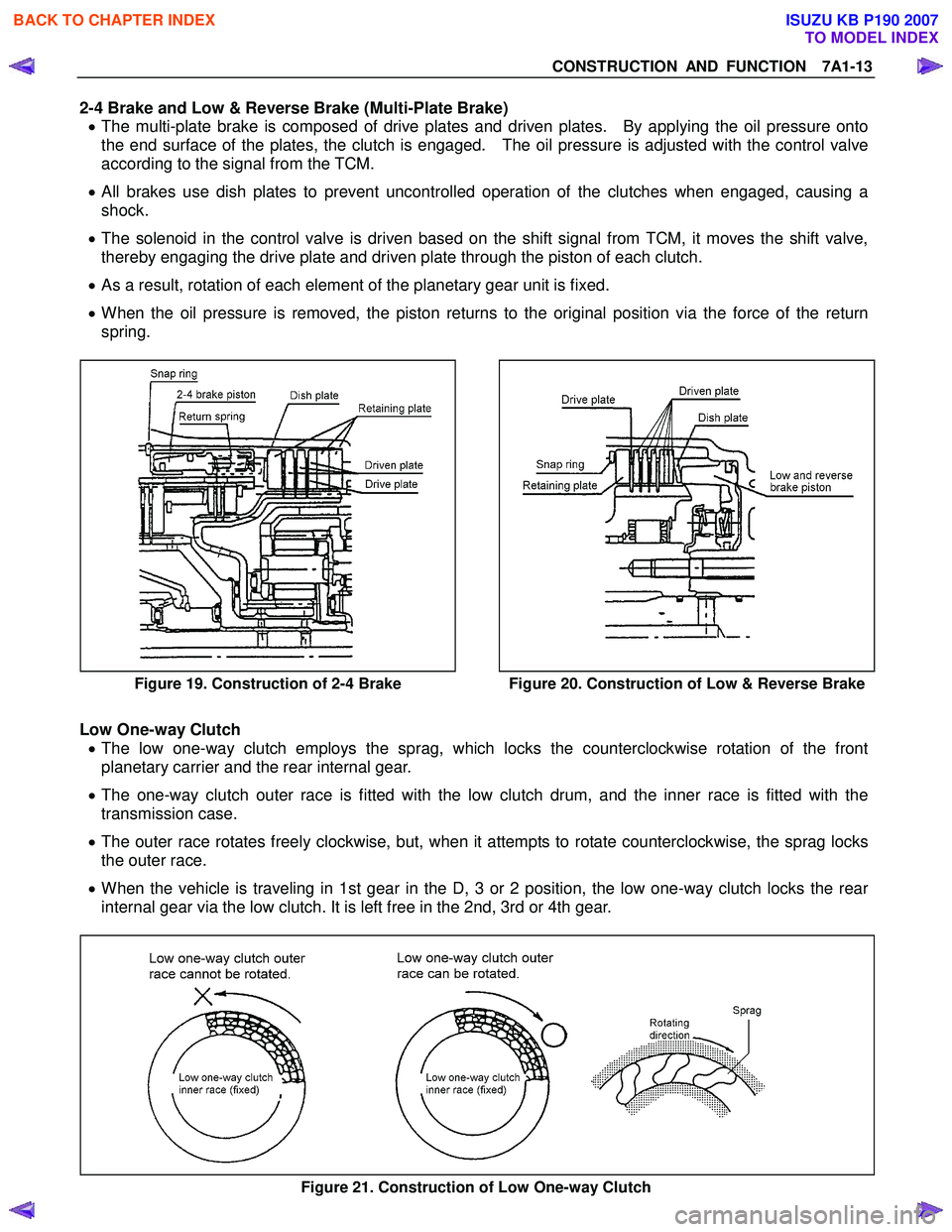
CONSTRUCTION AND FUNCTION 7A1-13
2-4 Brake and Low & Reverse Brake (Multi-Plate Brake) • The multi-plate brake is composed of drive plates and driven plates. By applying the oil pressure onto
the end surface of the plates, the clutch is engaged. The oil pressure is adjusted with the control valve
according to the signal from the TCM.
• All brakes use dish plates to prevent uncontrolled operation of the clutches when engaged, causing a
shock.
• The solenoid in the control valve is driven based on the shift signal from TCM, it moves the shift valve,
thereby engaging the drive plate and driven plate through the piston of each clutch.
• As a result, rotation of each element of the planetary gear unit is fixed.
• When the oil pressure is removed, the piston returns to the original position via the force of the return
spring.
Figure 19. Construction of 2-4 Brake
Figure 20. Construction of Low & Reverse Brake
Low One-way Clutch
• The low one-way clutch employs the sprag, which locks the counterclockwise rotation of the front
planetary carrier and the rear internal gear.
• The one-way clutch outer race is fitted with the low clutch drum, and the inner race is fitted with the
transmission case.
• The outer race rotates freely clockwise, but, when it attempts to rotate counterclockwise, the sprag locks
the outer race.
• When the vehicle is traveling in 1st gear in the D, 3 or 2 position, the low one-way clutch locks the rear
internal gear via the low clutch. It is left free in the 2nd, 3rd or 4th gear.
Figure 21. Construction of Low One-way Clutch
BACK TO CHAPTER INDEX
TO MODEL INDEX
ISUZU KB P190 2007
Page 4253 of 6020
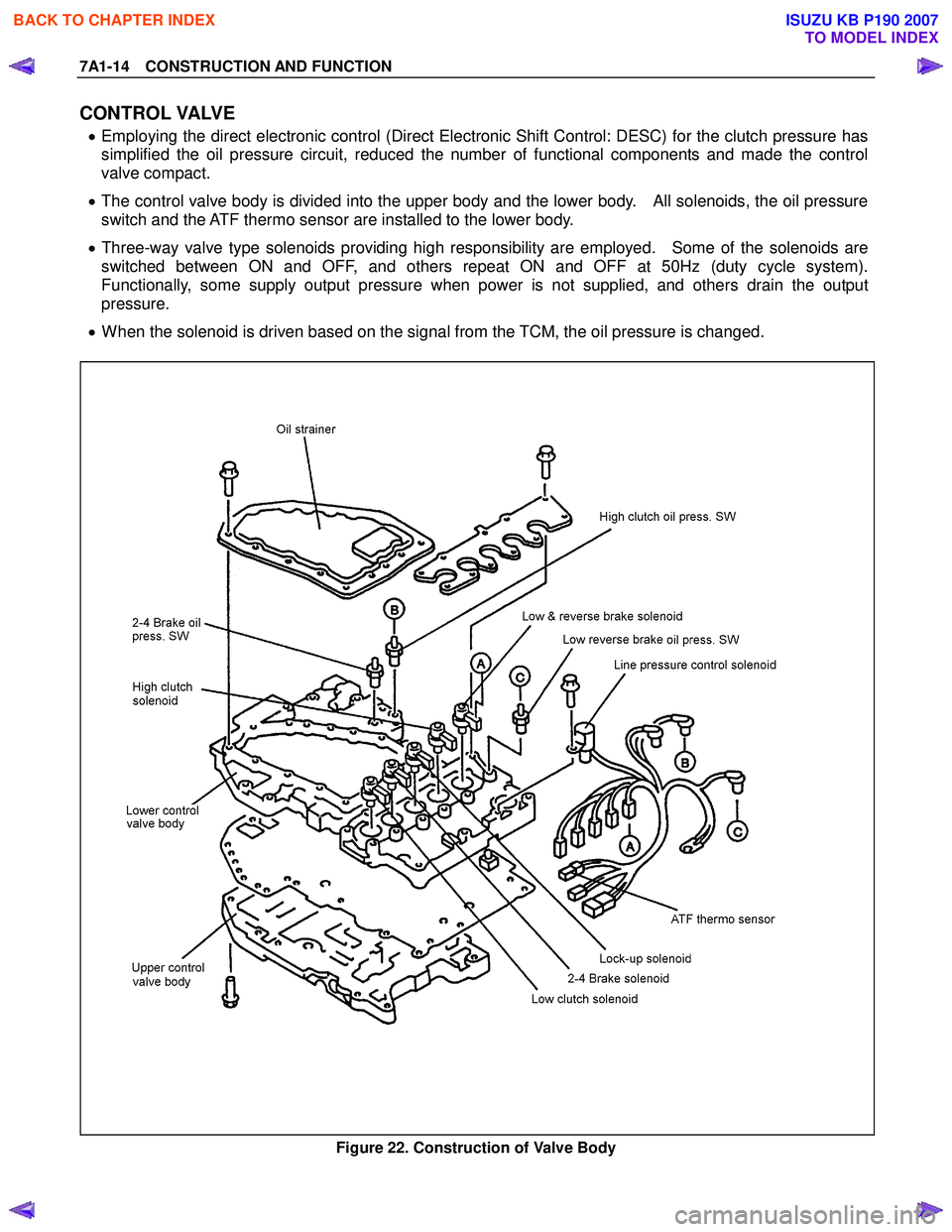
7A1-14 CONSTRUCTION AND FUNCTION
CONTROL VALVE
• Employing the direct electronic control (Direct Electronic Shift Control: DESC) for the clutch pressure has
simplified the oil pressure circuit, reduced the number of functional components and made the control
valve compact.
• The control valve body is divided into the upper body and the lower body. All solenoids, the oil pressure
switch and the ATF thermo sensor are installed to the lower body.
• Three-way valve type solenoids providing high responsibility are employed. Some of the solenoids are
switched between ON and OFF, and others repeat ON and OFF at 50Hz (duty cycle system).
Functionally, some supply output pressure when power is not supplied, and others drain the output
pressure.
• When the solenoid is driven based on the signal from the TCM, the oil pressure is changed.
Figure 22. Construction of Valve Body
BACK TO CHAPTER INDEX
TO MODEL INDEX
ISUZU KB P190 2007
Page 4255 of 6020
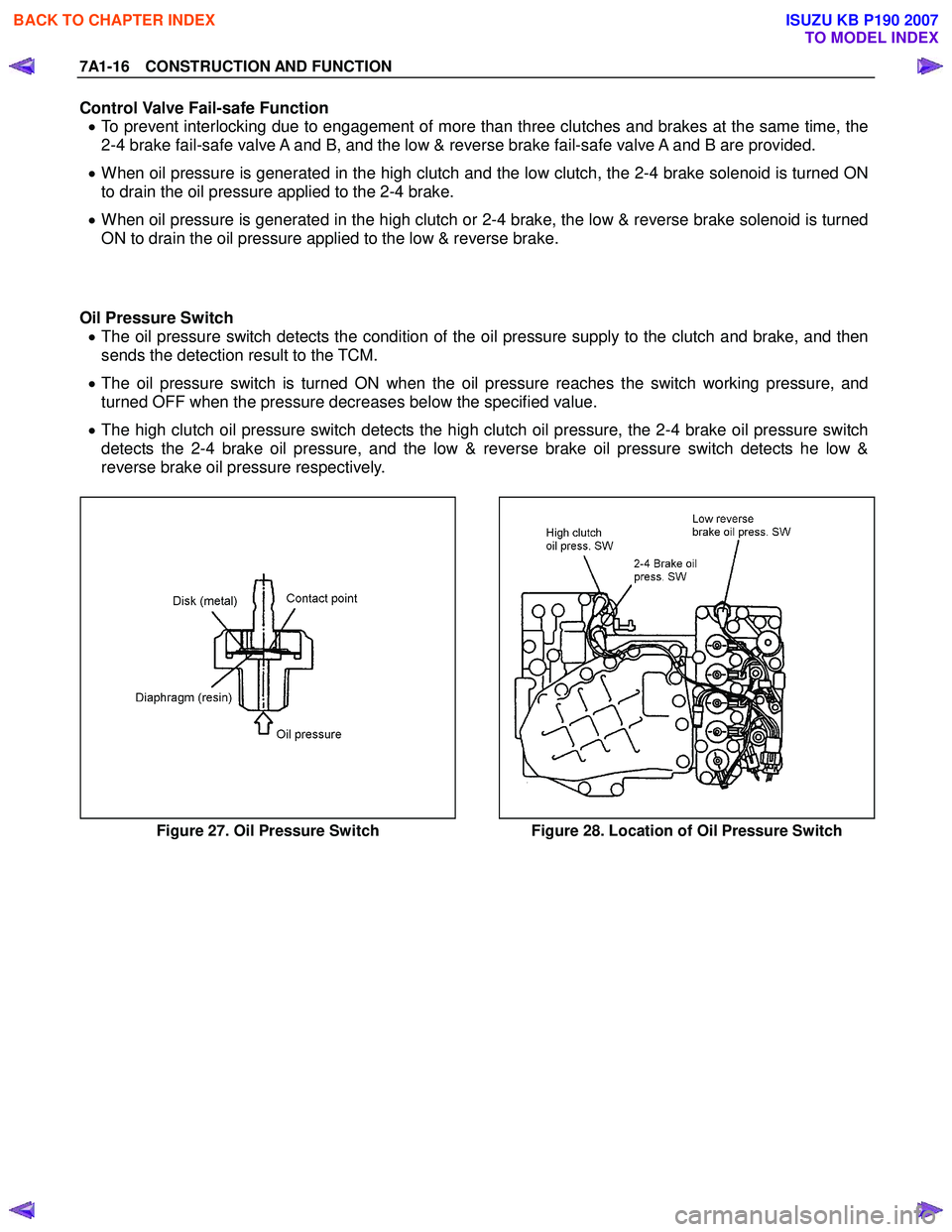
7A1-16 CONSTRUCTION AND FUNCTION
Control Valve Fail-safe Function • To prevent interlocking due to engagement of more than three clutches and brakes at the same time, the
2-4 brake fail-safe valve A and B, and the low & reverse brake fail-safe valve A and B are provided.
• When oil pressure is generated in the high clutch and the low clutch, the 2-4 brake solenoid is turned ON
to drain the oil pressure applied to the 2-4 brake.
• When oil pressure is generated in the high clutch or 2-4 brake, the low & reverse brake solenoid is turned
ON to drain the oil pressure applied to the low & reverse brake.
Oil Pressure Switch • The oil pressure switch detects the condition of the oil pressure supply to the clutch and brake, and then
sends the detection result to the TCM.
• The oil pressure switch is turned ON when the oil pressure reaches the switch working pressure, and
turned OFF when the pressure decreases below the specified value.
• The high clutch oil pressure switch detects the high clutch oil pressure, the 2-4 brake oil pressure switch
detects the 2-4 brake oil pressure, and the low & reverse brake oil pressure switch detects he low &
reverse brake oil pressure respectively.
Figure 27. Oil Pressure Switch Figure 28. Location of Oil Pressure Switch
BACK TO CHAPTER INDEX
TO MODEL INDEX
ISUZU KB P190 2007
Page 4257 of 6020
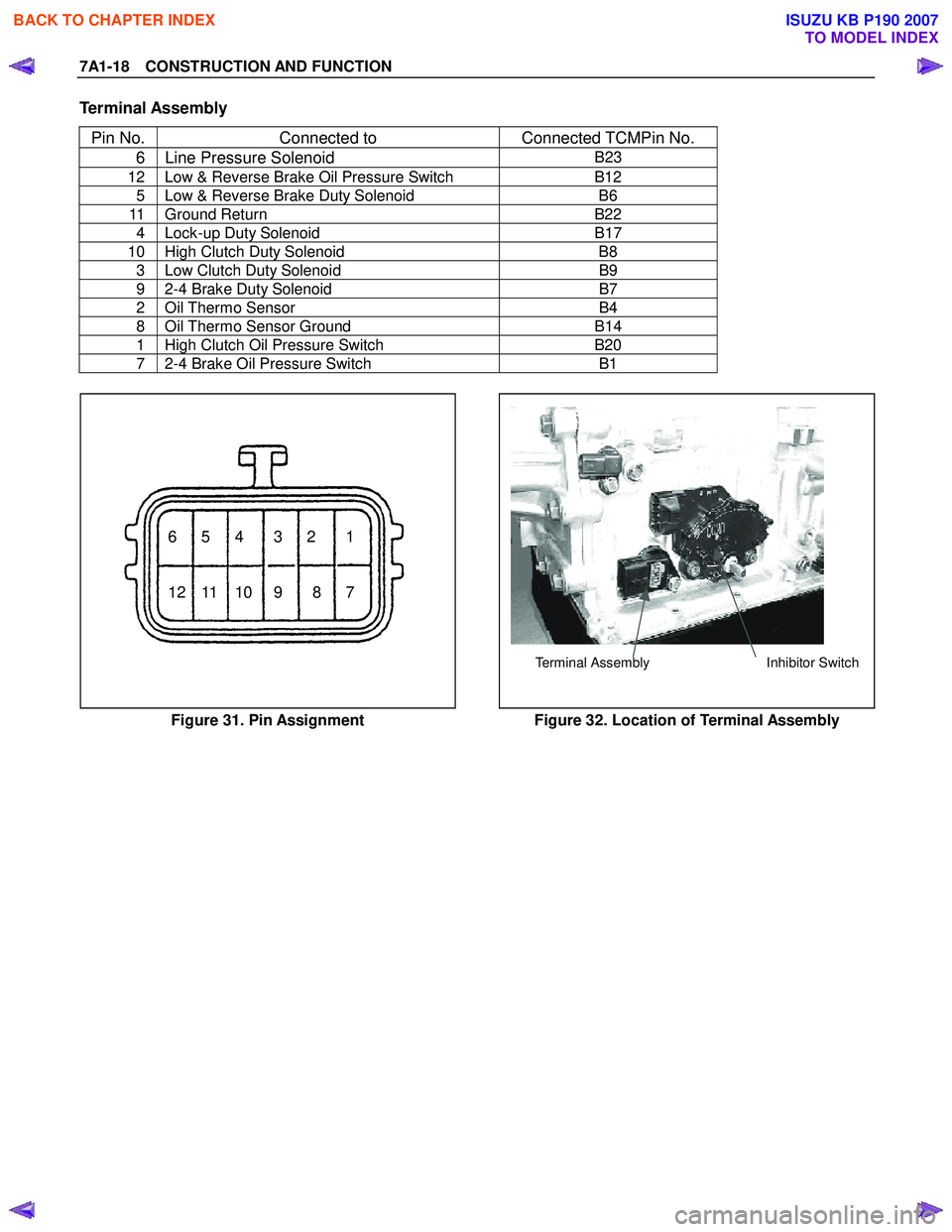
7A1-18 CONSTRUCTION AND FUNCTION
Terminal Assembly Pin No. Connected to Connected TCMPin No.
6 Line Pressure Solenoid B23
12 Low & Reverse Brake Oil Pressure Switch B12
5 Low & Reverse Brake Duty Solenoid B6
11 Ground Return B22
4 Lock-up Duty Solenoid B17
10 High Clutch Duty Solenoid B8
3 Low Clutch Duty Solenoid B9
9 2-4 Brake Duty Solenoid B7
2 Oil Thermo Sensor B4
8 Oil Thermo Sensor Ground B14
1 High Clutch Oil Pressure Switch B20
7 2-4 Brake Oil Pressure Switch B1
123456
891011127
Terminal AssemblyInhibitor Switch
Figure 31. Pin Assignment Figure 32. Location of Terminal Assembly
BACK TO CHAPTER INDEX
TO MODEL INDEX
ISUZU KB P190 2007